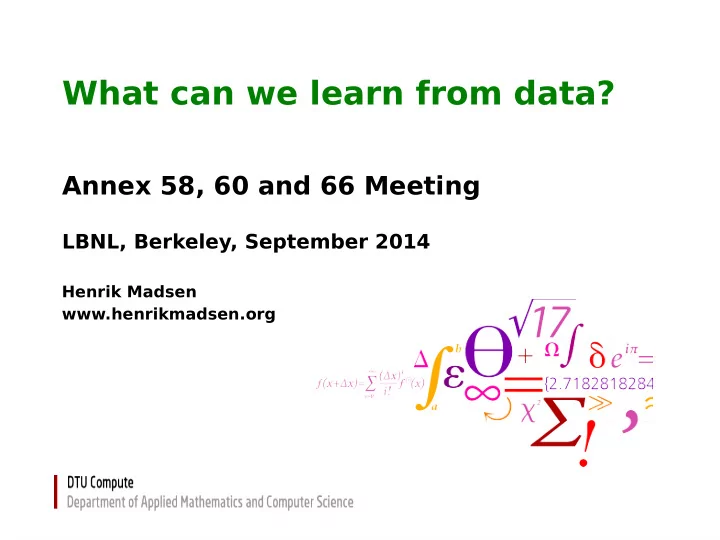

What can we learn from data? Annex 58, 60 and 66 Meeting LBNL, Berkeley, September 2014 Henrik Madsen www.henrikmadsen.org
Contents Non-parametric, conditional-parametric and semi-parametric models, .. (in Annex ?? ) RC-network, Lumped, ARMAX and grey-box models, .. ( Annex 58 ) Markov chain models, Generalized linear models, .. ( Annex 66 ) Examples only! Annex 58, 60 and 66 LBNL, Berkeley, September 2014
Part 1 Non-parametric methods Typically only data from smart meter (and a nearby existing MET station) Annex 58, 60 and 66 LBNL, Berkeley, September 2014
Data ● 10 min averages from 56 houses in Sønderborg Annex 58, 60 and 66 LBNL, Berkeley, September 2014
Case Study No. 1 Split of total readings into space heating and domestic hot water using data from smart meters Annex 58, 60 and 66 LBNL, Berkeley, September 2014
Splitting of total meter readings Annex 58, 60 and 66 LBNL, Berkeley, September 2014
Holiday period Annex 58, 60 and 66 LBNL, Berkeley, September 2014
Annex 58, 60 and 66 LBNL, Berkeley, September 2014
Case Study No. 2 Ident. of Thermal Performance using Smart Meter Data
Results Annex 58, 60 and 66 LBNL, Berkeley, September 2014
Perspectives for using data from Smart Meters Reliable Energy Signature. Energy Labelling Time Constants (eg for night set- back) Proposals for Energy Savings: Replace the windows? Put more insulation on the roof? Is the house too untight? ...... Optimized Control Integration of Solar and Wind Power using DSM Annex 58, 60 and 66 LBNL, Berkeley, September 2014
Case Study No. 3 Control of Power Consumption (DSM) Annex 58, 60 and 66 LBNL, Berkeley, September 2014
The Danish Wind Power Case .... balancing of the power system In 2008 wind power did cover the entire demand of electricity in In December 2013 and January 2014 more than 55 pct 200 hours (West DK) of electricity load was covered by wind power. And for several days the wind power production was more than 120 pct of the power load Annex 58, 60 and 66 LBNL, Berkeley, September 2014
Data from BPA Olympic Pensinsula project 27 houses during one year Flexible appliances: HVAC, cloth dryers and water boilers 5-min prices, 15-min consumption Objective: limit max consumption Annex 58, 60 and 66 LBNL, Berkeley, September 2014
Aggregation (over 20 houses) Annex 58, 60 and 66 LBNL, Berkeley, September 2014
Non-parametric Response on Price Step Change Model inputs: price, minute of day, outside temperature/dewpoint, sun irrandiance Olympic Peninsula 5 hours Annex 58, 60 and 66 LBNL, Berkeley, September 2014
Control of Energy Consumption Annex 58, 60 and 66 LBNL, Berkeley, September 2014
Control performance With a price penality avoiding its divergence Considerable reduction in peak consumption ● Mean daily consumption shift ● Annex 58, 60 and 66 LBNL, Berkeley, September 2014
Part 2 Parametric Models A model for the thermal characteristics of a small office building A nonlinear model for a ventilated facade Annex 58, 60 and 66 LBNL, Berkeley, September 2014
Case study Model for the thermal characteristics of a small office building Annex 58, 60 and 66 LBNL, Berkeley, September 2014
Flexhouse at SYSLAB (DTU Risø)
Model found using Grey-box modelling (using CTSM-R and a RC-model) Here we estimate the physical parameters
Modelling the thermal dynamics of a building integrated and ventilated PV module Several non- linear and time- varying phenomena. Consequently linear RC-network models are not appropriate. A grey-box approach using CTSM-R is described in Friling et.al. (2009)
Part 3 Non-gaussian models (Annex 66) ● Occupancy modelling is a necessary step towards reliable simulation of energy consumption in buildings Annex 58, 60 and 66 LBNL, Berkeley, September 2014
Occupant presence (office building in SF!) Annex 58, 60 and 66 LBNL, Berkeley, September 2014
Markov Chain Models Annex 58, 60 and 66 LBNL, Berkeley, September 2014
Model simulations Annex 58, 60 and 66 LBNL, Berkeley, September 2014
Remarks and Summary Other examples ... but not shown here: Shading (.. also dirty windows) Time-varying phenomena (.. eg. moisture in materials) Behavioural actions (opening of doors, windows, etc.) Appliance modelling Interactions with HVAC systems ........ . .. in general data and statistical methods (including tests) can be used to describe or model a number phenomena that cannot be described neither deterministically nor from first principles.
For more information ... ● See for instance www.henrikmadsen.org www.smart-cities-centre.org ● ...or contact – Henrik Madsen (DTU Compute) hmad@dtu.dk ● Acknowledgement CITIES (DSF 1305-00027B) Annex 58, 60 and 66 LBNL, Berkeley, September 2014
Some 'randomly picked' books on modeling .... 2008 2011
Annex 58, 60 and 66 LBNL, Berkeley, September 2014
Annex 58, 60 and 66 LBNL, Berkeley, September 2014
Recommend
More recommend